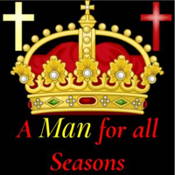
Overview
Synopsis
Playwright Robert Bolt had a long-standing fascination with the story of Sir Thomas More, an English statesman and lawyer who served as Lord High Chancellor of England under King Henry VIII. More fractured his relationship with the monarchy when he refused to take the Oath of Supremacy swearing allegiance to the monarchy as the head of the Church of England. He also refused to legitimize the annulment of Henry’s marriage to Catherine of Aragon. The intrigue surrounding the plot to secure the divorce and More’s subsequent persecution is the basis of A Man for All Seasons. Narrated by a man identified only as Common Man (who also plays a number of ensemble parts), the play follows More as he is confronted by antagonistic forces like the powerful Cardinal Wolsey and the opportunistic Richard Rich. King Henry VIII himself makes an appearance as well, portrayed as a youthful drunkard burdened by sin but determined to overcome God’s punishment and secure an heir to the throne. With moments of rich humor and transparent theatricality, the play is an homage to the style of Bertolt Brecht that paints a portrait of More not as a heroic martyr but as a victim of his own sense of morality.
Show Information
Context
Plot
Characters
| Name | Part Size | Gender | Vocal Part |
|---|---|---|---|
|
Lead |
Male |
Non-singer |
|
|
Supporting |
Male |
Non-singer |
|
|
Supporting |
Male |
Non-singer |
|
|
Supporting |
Female |
Non-singer |
|
|
Supporting |
Male |
Non-singer |
|
|
Supporting |
Male |
Non-singer |
|
|
Supporting |
Male |
Non-singer |
|
|
Supporting |
Female |
Non-singer |
|
|
Featured |
Male |
Non-singer |
|
|
Featured |
Male |
Non-singer |
|
|
Featured |
Male |
Non-singer |
|
|
Ensemble |
Male |
Non-singer |
|
|
Ensemble |
Male |
Non-singer |
|
|
Ensemble |
Male |
Non-singer |
Songs
A song with an asterisk (*) before the title indicates a dance number; a character listed in a song with an asterisk (*) by the character's name indicates that the character exclusively serves as a dancer in this song, which is sung by other characters.
Monologues
Scenes
Key Terms
Relating to the theatrical style of Bertolt Brecht, emphasizing social critique and distancing the audience from emotional immersion.
A high-ranking church official, typically used in period or religious dramas to embody power, hierarchy, or moral dilemma.
A performance technique where an actor speaks directly to the audience, breaking the fourth wall for dramatic or comedic effect.
The act of selling goods, often used in theatre to characterize the working class or depict street life and economic struggle.
A senior official in English government or monarchy, found in historical drama as a figure of law, influence, or secrecy.
The betrayal of one’s country, commonly portrayed in political and historical plays as a central conflict involving loyalty and power.
Videos
Quizzes
Themes, Symbols & Motifs
Sorry! We do not currently have learning modules for this guide.
Quote Analysis
Sorry! We do not currently have learning modules for this guide.
